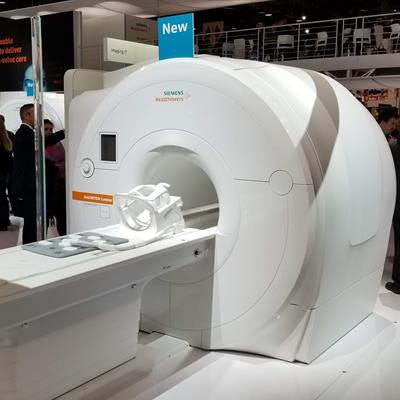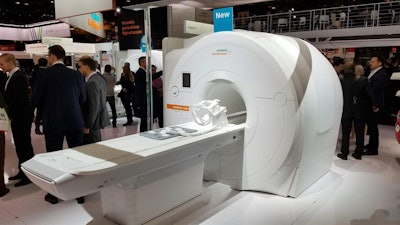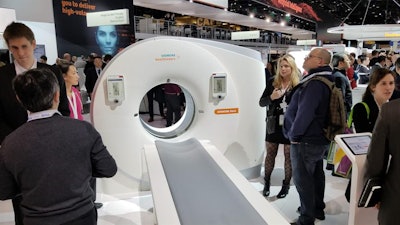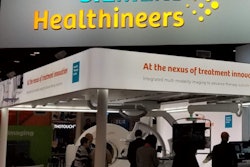
CHICAGO - Siemens Healthineers is debuting a range of new products at this week's RSNA 2018 meeting, including new MRI scanners based on its BioMatrix technology, artificial intelligence (AI) for CT, and new x-ray systems.
MRI
Siemens is introducing two new MRI scanners at this year's meeting based on the BioMatrix concept: the Magnetom Lumina 3-tesla scanner and the Magnetom Altea 1.5-tesla system. The scanners offer a more affordable price point than previous BioMatrix models.
 Siemens' new Magnetom Lumina 3-tesla scanner.
Siemens' new Magnetom Lumina 3-tesla scanner.First introduced in 2017, the BioMatrix concept features the use of sensors and tuners to automatically adapt scanner protocols to patient anatomy. For example, sensors embedded in the table of a BioMatrix scanner track the patient's breathing, helping users select the optimal scan protocol, while specialized radiofrequency (RF) coils set optimal scan parameters based on patient anatomy.
The original BioMatrix scanners were the 3-tesla Magnetom Vida and the 1.5-tesla Magnetom Sola. With Lumina and Altea added to the family, Siemens is rolling out the concept to more cost-efficient scanners with 70-cm magnet bores.
Siemens has also developed new sequences and acceleration technologies for the systems. In addition to the company's Turbo Suite MR acceleration package, Lumina and Altea have optimized workflow designed to reduce unwanted variation in scans between patients. Users of the new systems will also have access to the company's Dot automated workflow engines.
Meanwhile, Innovision is a new in-bore patient entertainment system that not only lets users show customized video content to patients but also includes a mirror inside the bore that gives patients the illusion of being in a larger space. Siemens also has a new solution for noise cancellation that results in quieter scans.
Finally, the new Turbo Suite Excelerate package brings simultaneous multislice imaging to turbo spin-echo sequences as well as the company's Resolve sequence, cutting orthopedic scanning by 50%, while Compressed Sensing is being expanded out of cardiac and body scanning to other clinical applications.
Lumina is available with the company's XK gradient with an amplitude of 36 mT/m and a slew rate of 200 T/m/sec, while Altea is available with an XJ gradient and a 33-mT/m amplitude and 125-T/m/sec slew rate. The field-of-view on the scanners is 55 x 55 x 50 cm for Lumina and 50 x 50 x 50 cm for Altea.
Siemens plans to begin serial shipments of Lumina and Altea in the spring of 2019 after receiving appropriate regulatory clearances; the first customer installations are going in now.
Other MRI product introductions being highlighted at RSNA 2018 are a blanket Contour coil that's available with 24 or 48 elements and a BioMatrix version of Magnetom Amira, a 60-cm scanner sold mostly in international markets. Two new BioMatrix sensors will be introduced for Magnetom Vida: one called Kinetic that's integrated into the magnet bore for motion correction and one called Beat for capturing cardiac signals. Both sensors are available not only for Vida but also for Sola, and the Beat sensor is also optionally available for the Lumina and Altea scanners.
CT
Siemens is bringing artificial intelligence (AI) to CT with the debut of AI-Rad Companion Chest CT, the first in a line of what Siemens is calling an "intelligent software assistant" for radiology.
AI-Rad Companion Chest CT takes CT chest images and uses an algorithm to differentiate between various thoracic structures, highlight them individually, and mark and measure potential abnormalities in the lungs, heart, aorta, and coronary arteries. It also performs clinical tasks such as identifying, localizing, labeling, and measuring lung lesions. The application then automatically translates its findings into structured reports, according to the company.
The application is designed to help radiologists interpret images and potentially reduce the amount of time spent documenting results, generating standardized reports that are both quantifiable and reproducible. It uses a cloud-based platform and also is part of teamplay, Siemens' infrastructure for collaboration.
AI-Rad Companion Chest CT is a multivendor solution that can analyze data from any CT manufacturer, and it will be offered on a pay-per-use basis, according to the company. It is pending 510(k) clearance from the U.S. Food and Drug Administration (FDA).
Also on display in the CT section of the company's booth were the Somatom Force and Somatom go scanner lines. More than 1,500 systems have been sold in the Somatom go line, with over 1,000 installations completed, according to the company.
 Siemens' Somatom Force CT scanner.
Siemens' Somatom Force CT scanner.Artificial intelligence
In artificial intelligence, Siemens debuted its AI-Pathway Companion at RSNA 2018. The clinical decision-support system is based on AI that helps physicians make diagnostic and therapeutic decisions along a patient's clinical pathway. The system provides caregivers with the person's current status, most recent tests and results, and a history of his or her previous experiences and data. For each case, AI-Pathway Companion aggregates patient history, test results, and clinical studies and then analyzes the data.
AI-Pathway Companion's configuration allows physicians to scroll backward and forward to observe a virtual timeline of the patient's previous and current care. The system is designed to recognize patterns and irregularities in data and can help multidisciplinary disease boards make suggestions for patient treatment based on recommended guidelines, such as those from the National Cancer Institute.
In addition, because AI-Pathway Companion's user interface is intuitively designed, physicians can more easily discuss the results with their patients and make joint decisions about how to proceed.
AI-Pathway Companion currently is in development in the U.S., the U.K., Germany, the Netherlands, and Switzerland. Siemens expects the AI system to be available next year.
At RSNA 2018, Siemens is also showing its syngo Virtual Cockpit software, which allows specialists to connect remotely to MRI, CT, PET/CT, and PET/MRI scanners to assist staff in imaging patients who require more sophisticated or complex exams.
Experienced technologists using the syngo Virtual Cockpit could access control of as many as three remote scanners at any one time. These specialists would connect to remote personnel in real-time through headsets, conference speakers, or chat and video functions and be able to adjust protocol parameters. However, for patient safety reasons, they would be prohibited from any actions or access regarding contrast or radiation dose.
X-ray
The company is also launching a new floor-mounted digital radiography (DR) room called Multix Impact at RSNA 2018. The unit features a height-adjustable float-top table that isn't typically found in x-ray systems at this price point, according to Siemens.
 The Multix Impact floor-mounted digital radiography room.
The Multix Impact floor-mounted digital radiography room.Multix Impact has an in-room touch user interface on the x-ray tube that allows technologists to remain at the patient's side; or, technologists can monitor and optimize positioning from the control room via the system's patient positioning camera. This potentially reduces repeat x-rays and unnecessary patient radiation dose, according to the company.
Siemens is highlighting the user interface on Multix Impact, which includes a graphical organ program selection feature that can help technologists work faster. A positioning guide display is available on both the in-room touch user interface and the workstation.
The system also has colored lighting at the top that can help notify patients of their exam status, and it uses wireless 17 x 15-inch digital detectors. Multix Impact is pending 510(k) clearance from the FDA.
Mobilett Elara Max, a mobile x-ray unit, is another new x-ray system. Given the increasing concern regarding hospital-acquired infections, Siemens designed the system to be easily disinfected, with cables hidden inside the unit's articulating arm and the entire system given an antimicrobial coating.
Mobile x-ray systems are being used in a variety of environments and need to be easily integrated into a hospital's IT infrastructure, so Siemens included a comprehensive security package on Elara Max to fend off cyberattacks. It also sports "virtual workstation" technology that enables the installation of additional hospital software to provide access to patient information at the bedside without affecting the safety of the system.
Elara Max has the same user interface found across Siemens' Max line of x-ray systems, making it easy for technologists to switch between systems. Elara Max is pending 510(k) clearance.
Interventional x-ray
A major highlight in the interventional x-ray section of Siemens' booth is the Nexaris room, which combines an angiography system with a CT scanner to support a broader range of interventional procedures. At RSNA 2018, Siemens is showing a Nexaris room that also has the company's Freestyle wireless ultrasound probe added to the configuration.
 Siemens' Nexaris room for interventional radiology.
Siemens' Nexaris room for interventional radiology.Users can perform ultrasound scans with Freestyle and have the images transferred via Apple's Apple TV wireless protocol to a large monitor at the patient's bedside. The company has also added a fixed mount that enables a physician's tablet computer or smartphone to be positioned at the bedside, with images sent to the monitor for consultation.
Ultrasound
In ultrasound, Siemens is highlighting the ability of its Acuson Sequoia scanner with its deep abdominal transducer (DAX), a 1.2-3.5-MHz ultrasound probe, to penetrate deep into tissue by scanning Ryuichi Yamamoto, also known as Yama, a 600-lb retired sumo wrestler. The demonstration indicates that Sequoia with DAX can be useful in scanning obese patients, with no loss of frame rate and full focus throughout the depth of field. The DAX probe was launched in June 2018.
Siemens is also highlighting Acuson Juniper, which launched in March 2018. The scanner has a small, light footprint and features 16 probes. The scanner is the first in what will be a growing line of systems, according to the company.
Women's imaging
Siemens is highlighting new AI-based features for its syngo.Breast Care mammography reading and reporting workstation. The new features are designed to leverage the power of AI to give physicians clinical decision support when reading mammograms.
The algorithms are designed to help evaluate individual breast lesions and provide system evaluation for 2D mammograms or tomosynthesis. The planned software is also designed to sort cases automatically and score the cases with a value of 1 to 10. The case score is intended to take into account any existing lesions, microcalcifications, and other abnormalities. The scoring is powered by the Transpara technology developed by ScreenPoint Medical; it is being shown in the Siemens booth as a work-in-progress.
Molecular imaging
Siemens' Biograph Vision PET/CT scanners were on display at this year's meeting. The system's Optiso Ultra Dynamic Range (UDR) detector features 3.2-mm lutetium oxyorthosilicate (LSO) crystal elements for enhanced spatial resolution to visualize smaller lesions. Its silicon photomultiplier sensors are designed to improve time-of-flight PET for better contrast and signal-to-noise ratio. The combination allows clinicians to balance dose with image quality and in some cases perform whole-body scans in as little as four minutes.
The addition of CardioFreeze software is designed to reduce image blur from cardiac and respiratory motion using only the electrocardiogram trigger for gating. The goal is to improve visualization of myocardial tracer distribution and uptake, wall thickness, and defect definition.
OncoFreeze also offers enhanced images by mitigating respiratory motion without extending scan time.




















